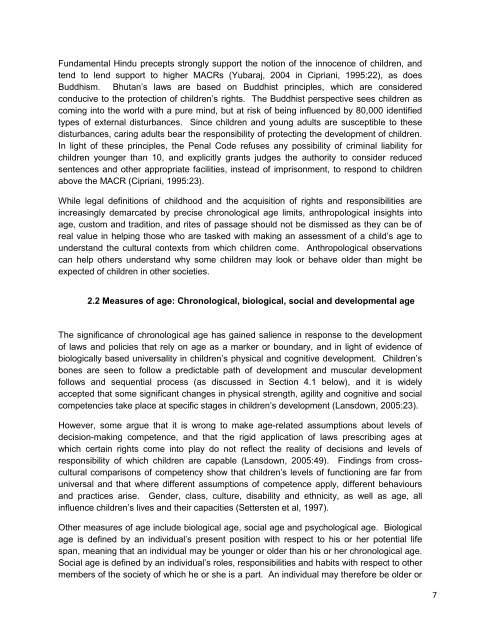Age assessment practices: a literature review & annotated ... - Unicef
Age assessment practices: a literature review & annotated ... - Unicef
Age assessment practices: a literature review & annotated ... - Unicef
Create successful ePaper yourself
Turn your PDF publications into a flip-book with our unique Google optimized e-Paper software.
Fundamental Hindu precepts strongly support the notion of the innocence of children, and<br />
tend to lend support to higher MACRs (Yubaraj, 2004 in Cipriani, 1995:22), as does<br />
Buddhism. Bhutan‟s laws are based on Buddhist principles, which are considered<br />
conducive to the protection of children‟s rights. The Buddhist perspective sees children as<br />
coming into the world with a pure mind, but at risk of being influenced by 80,000 identified<br />
types of external disturbances. Since children and young adults are susceptible to these<br />
disturbances, caring adults bear the responsibility of protecting the development of children.<br />
In light of these principles, the Penal Code refuses any possibility of criminal liability for<br />
children younger than 10, and explicitly grants judges the authority to consider reduced<br />
sentences and other appropriate facilities, instead of imprisonment, to respond to children<br />
above the MACR (Cipriani, 1995:23).<br />
While legal definitions of childhood and the acquisition of rights and responsibilities are<br />
increasingly demarcated by precise chronological age limits, anthropological insights into<br />
age, custom and tradition, and rites of passage should not be dismissed as they can be of<br />
real value in helping those who are tasked with making an <strong>assessment</strong> of a child‟s age to<br />
understand the cultural contexts from which children come. Anthropological observations<br />
can help others understand why some children may look or behave older than might be<br />
expected of children in other societies.<br />
2.2 Measures of age: Chronological, biological, social and developmental age<br />
The significance of chronological age has gained salience in response to the development<br />
of laws and policies that rely on age as a marker or boundary, and in light of evidence of<br />
biologically based universality in children‟s physical and cognitive development. Children‟s<br />
bones are seen to follow a predictable path of development and muscular development<br />
follows and sequential process (as discussed in Section 4.1 below), and it is widely<br />
accepted that some significant changes in physical strength, agility and cognitive and social<br />
competencies take place at specific stages in children‟s development (Lansdown, 2005:23).<br />
However, some argue that it is wrong to make age-related assumptions about levels of<br />
decision-making competence, and that the rigid application of laws prescribing ages at<br />
which certain rights come into play do not reflect the reality of decisions and levels of<br />
responsibility of which children are capable (Lansdown, 2005:49). Findings from crosscultural<br />
comparisons of competency show that children‟s levels of functioning are far from<br />
universal and that where different assumptions of competence apply, different behaviours<br />
and <strong>practices</strong> arise. Gender, class, culture, disability and ethnicity, as well as age, all<br />
influence children‟s lives and their capacities (Settersten et al, 1997).<br />
Other measures of age include biological age, social age and psychological age. Biological<br />
age is defined by an individual‟s present position with respect to his or her potential life<br />
span, meaning that an individual may be younger or older than his or her chronological age.<br />
Social age is defined by an individual‟s roles, responsibilities and habits with respect to other<br />
members of the society of which he or she is a part. An individual may therefore be older or<br />
7
















